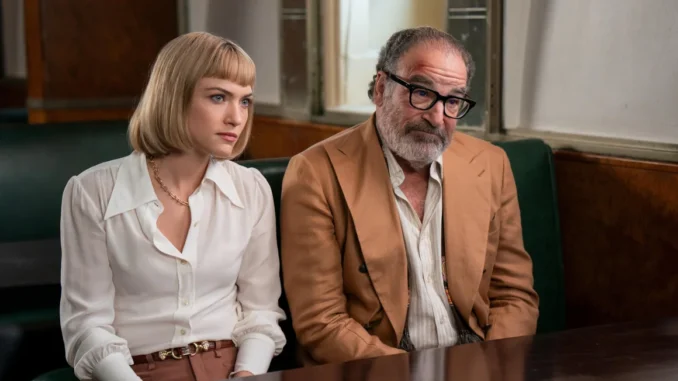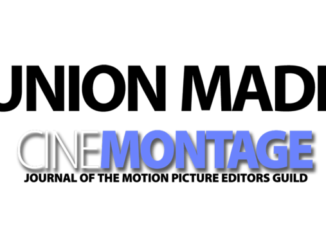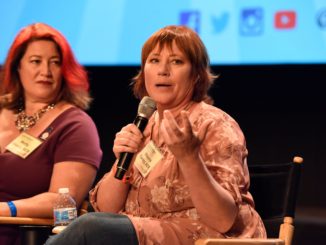
By Patrick Z. McGavin
“I’m a huge fan of murder mysteries,” says the picture editor Franzis Müller.
That helps explain her newest project, the Hulu series “Death and Other Details,” a marriage of Agatha Christie and “Succession.” The story is about a dynastic family business becoming unraveled after a murder aboard a luxury ship.
The show stars Violett Beane as a young woman confronting her traumatic past and Mandy Patinkin as a celebrated detective tasked with solving the mystery.
Müller – who was born in Venezuela and studied filmmaking at AFI – cut the third, sixth and ninth episodes of the 10-part series.
CineMontage: What drew you to this material?
Franzis Müller: Being a fan of murder mysteries and just putting puzzles together really caught my eye. So that was the first thing that piqued my interest. By the time my agent approached me, the pilot was shot, and I watched that. I thought it was really interesting. I’m a huge fan of Mandy Patinkin. That was a plus. In talking with the showrunners during the interview, they didn’t really go into too much detail because they didn’t want to spoil anything. I really loved the plan they had for the story.
CineMontage: One of the themes of the show is illusion. How much did that influence your creative choices?
Franzis Müller: I’m not sure if we’re playing so much with illusion, but illusion is a big part of the script. The line Mandy says in the pilot, or variations of it multiple times, is that the truth is in the details. That follows so much of what we do as editors.
It’s about the details in the performances, and the details of the cuts that we do, to try and tell the story and guide the audience the best way possible, and make sure we’re not confusing anybody. We want to make sure they’re entertained, and we’re taking them on a ride from start to finish.
CineMontage: By the time you cut your first episode, the template was already established. Does that constrain your work, or free you up?
Franzis Müller: I don’t feel like it was creating any restraints on my work. It was more about, this is what has been built so far. We had the basic pillars to work from, but the showrunners and creators always encouraged us to put our own spin on it, and just make it the best way possible. We owed the inspiration in the sense this was the tone that was set up. I don’t want to speak for the other editors, but this was a big point for me.
There was a tone and a very recognizable score that was set up, and that does a big part of the heavy lifting. The question was more about how much more I could push the performances, and the creative art that was built for us so I could carry the story. We have a lot of characters on the show, and they’re all interconnected. It’s a lot of playing around with different personalities that are established in the pilot, and we have to carry it for the rest of the show.

CineMontage: What’s the trickiest part of playing with time and linear order with the use of the flashbacks?
Franzis Müller: At least for the episodes I worked on, the flashbacks were built into the script. They were maybe not built into the specific scene, so it was about finding the right moment to go into the flashback to tell the story, and drag the clues throughout.
In the third episode, the first one I cut, there is a very long flashback with a lot of information that lands toward the middle of the scene. We had to make sure we went into the flashback at the right moment, so people aren’t confused and asking why are we jumping back to tell a different side of the story. The key concentration was am I going into this flashback in the right moment at the right time? Does it feel correct for the character to take a step back, and think about this moment here and then.
CineMontage: The murder on the ship is framed by the earlier unsolved murder of 18 years earlier. It’s about how the past is superimposed over the present.
Franzis Müller: Definitely. I also think a lot of the interaction Rufus (Patinkin) and Imogene (Beane) have is trying to solve the current murder, and also the earlier murder of her mother. There’s a group that feels she has to be open to all the information around her, and not try to connect everything to her mother’s death. We had to find the correct ways to introduce the flashbacks to her mother’s death so the audience is reminded how important this is for Imogen, but there is also a bigger picture, the murder at the beginning, and what we see through the rest of the series, jumping back and forth between the two, and trying to present the two stories.
CineMontage: There is a lot of permissiveness with sex, nudity, violence and language. That must have been fun and liberating to work without restriction.
Franzis Müller: Absolutely. Not having a lot of restrictions is always great, not just for the editors, but I think for every filmmaker, I think as long as it serves the purpose of the story. It’s an important thing to keep in mind. I don’t think any of those moments are done for shock value. They served a purpose in the story. That was fun, but it was also important to make sure it didn’t feel like a gimmick. We’re telling a story about regular people, and how people behave.
CineMontage: Is the editing meant to deliberately obfuscate the lines between truth and lies?
Franzis Müller: I think it’s a fine balance between the two. I don’t think we are ever trying to trick the audience into thinking one thing. I think they’ll feel betrayed by the end of the show, that we’ve led them in one direction, and that’s not where they were supposed to go. I think we go hand in hand with the audience. We want to make it an enjoyable experience, but we also can’t make it easy. That’s part of the fun of murder mysteries. You have to show all the suspects so people can jump to their own conclusions by the end of the show. Hopefully by the time they get to the two-part conclusion, they have an idea who the guilty party is, and they’ve had a great time putting the quiz together, putting the details together.
Hopefully we’ve done it in a way that we haven’t confused them or bored them at any point throughout the show. It’s more we’re presenting the case to you as the detectives.
CineMontage: Even if the episodes are interlinked, did you feel there were moments for asides, digressions or just letting the show breathe?
Franzis Müller: I think one of the one of the things I really loved about a script is even though all the stories and characters are interconnected, we had the moments or just little pockets of information where we get to learn a little bit more about each of the characters as we move through the series. People can make their own conclusions as we get to the end of the show.
You have examples like episode five where it’s a bit of a standalone piece that takes place on land, or episode seven, which jumps around and goes to the past, so you have those moments where the audience can breathe and connect with a character.
CineMontage: You worked with a different director on each episode. Was was that creative dynamic like?
Franzis Müller: I always make a point to communicate with the director before they start shooting, introduce myself and just let them know that I’m available throughout the shooting if they want to look at a scene. I could send assemblies to them, so they know where things are going and I am able to communicate with them as they’re shooting to just let them know. I could tell them the footage is cutting great, or we’re having issues here or there, and just spend time with them.
Everybody was working from home, but we were communicating forever through the different cuts. Each director has their own way of working. Some like to send notes. Some like to spend more time going through the footage. They each had their own style, and their own ideas. It was just a matter of molding myself to how they work.
CineMontage: Is there something about the process or technique of editing that merges with your personality or artistic sensibility?
Franzis Müller: I’m someone that likes to solve puzzles, or build Legos, that kind of king. The way I view editing is just having a lot of pieces together, with not necessarily a clear vision of what you want from start to finish, but you’re molding and building it for a while, and then you get to the final picture. In the end, it’s a wonderful, beautiful, and magical experience. I know I have all of these pieces that I can put together in various different ways. There isn’t just one way to do it. You have infinite ways of approaching the scene. That part is great. I enjoy the solitary aspect of editing.
CineMontage: Do you have your own style, or is it malleable to the demands of a specific show?
Franzis Müller: I think I’ve been able to adjust that as I go. As I go through and watch things, I can’t think it’s one specific style. I see little details here and there that are a very specific style of polishing that I like. I think it’s about molding myself to projects rather than having a very specific style that’s worked for me.
CineMontage: How would you describe your process?
Franzis Müller: When I finish cutting all the dailies, the first thing I do is watch a whole episode or more whatever I’m working on without any sound. By the time I get to the end of whatever I’m watching that I’ve cut, I feel comfortable with it.
I know that I have a good base, and from there I’m going to add the sound, add the music, and that is just going to elevate the picture that much more. For me that is my favorite part, when I finish cutting dailies, and really take a step back, as if I were an audience member, and just focus on the picture. If I see there’s potential for it to grow, that’s my favorite part of the creative process.
Patrick Z. McGavin is a Chicago-based cultural journalist. He maintains the Substack newsletter, “Shadows and Dreams” (www.patrickzmcgavin.substack.com)





